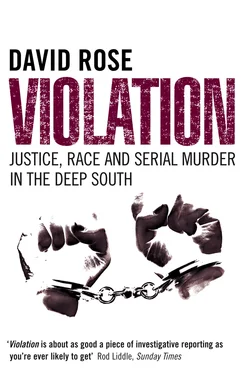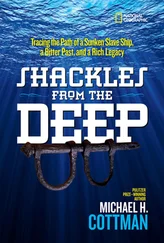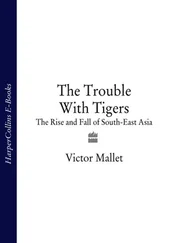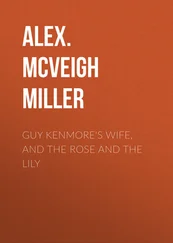‘At busy times, like the weeks before Christmas, Carlton would have been appearing in five TV spots a night. I guess that made him kind of easy to recognise.’ Nine years after working for Hewell, Gary would find himself standing trial for the Columbus stocking stranglings.
The rapes and murders of Florence Scheible and Martha Thurmond in October 1977, followed by Carl Cannon’s exposure of the CPD’s incompetence, plunged Columbus into a new abyss of fear. More than two decades later, in his chambers in the Government Center tower, I met Andrew Prather, a State Court judge who had lived alone in Wynnton at the time of the murders. Despite the belief that the killer was black, he said, any single man was regarded as a possible suspect: ‘There was a police car parked outside and I knew they were watching me. I thought of moving to Atlanta but then I thought, “What if I leave town and the killings stop?”’
One night he found an old lady’s dog in the street. ‘I was scared to give it back. I thought I was going to get shot. I yelled through the door, “It’s Andy Prather! I live down the street and I’ve got your puppy!”’ His fears were well founded. In one reported incident, a woman fired a pistol through her glass front door when she saw the shadow of a friend and neighbour who was calling to check her well-being.
As the police stumbled to make progress, they asked for help from the famous FBI criminal psychology profile expert, Robert K. Ressler. In his memoirs, Ressler writes of attending a social gathering during his visit: ‘A group of middle-aged and elderly women were at a party together, and the main topic of conversation was the mysterious series of killings. At one point in the evening, in a demonstration of how completely the fear of the killer had gripped the city, seven of the women guests emptied their purses, revealing seven handguns that fell out on to the carpet.’ Meanwhile, the local media advised single and widowed women to move in with male relatives, and if that were not possible, to form ‘communes’ for their own protection.
Aware that he and his colleagues had no suspect, Detective Richard Smith and his partner, Frank Simon, decided to try prevention. Before the murders began, Smith had been responsible for a programme designed to protect store-owners from robbery – the Columbus Anti-Robbery Enforcement System, or CARES. Possible targets were identified, and then equipped with panic button hotlines to the police, who were supposed to respond immediately.
‘Now,’ said Smith in his New York office, gazing into the middle distance through a mist over Central Park, ‘I had to profile the elderly women and widows who lived alone in Wynnton, then go to them and tell them, as if they didn’t already know, that they were likely victims of the strangler. The harder task was to convince them that they were going to be safe, that we were going to protect them. They didn’t have family, so we were it.’
Smith fitted dozens of these possible victims’ homes with alarms activated by panic buttons and pressure pads placed under the carpets outside their bedrooms. ‘They were very expensive units, hooked directly up to police radio bands. Unfortunately, the only result was very, very many false alarms.’ Time and again, a woman would hear something, then press her button almost reflexively. Some did it so often that the police had to take their alarms away.
‘I got to know some of those women quite intimately,’ Smith said. ‘What I do remember is that when one of them raised the alarm, what seemed like the whole world of policing would show up within seconds. One night I was on patrol with a guy from the GBI [the Georgia Bureau of Investigation]. A call went out that a guy had heard screaming from the home of his neighbour, a widow. We weren’t more than half a mile away, but by the time we got there, we had to park three blocks from the house, there were so many law-enforcement vehicles there already.’
Working with the help of official records, it took Smith hours of work to produce his list of possible victims.
‘How do you think the strangler managed to carry out his own profiling?’ I asked. ‘How did he work out where elderly women were living alone?’
Smith paused for a long time. ‘We don’t know. Until the day I left the force, I had no idea how he selected his victims.’
Anyone – especially anyone African-American – walking through Wynnton was likely to be stopped and asked to submit to a pro-forma ‘field interview’, with their personal details and movements for the past few days taken down and filed. Some were asked to give saliva and hair samples. Many of those stopped were students, on their way to the black high school in Carver Heights, and when they were questioned again and again, it aroused fierce resentment. However, flooding Wynnton with law-enforcement officers seemed to work.
‘We were not allowed in that neighbourhood – there’s no way that I could have gone through Wynnton after six or seven at night without being jumped on by every police car in the city,’ Gene Hewell said. ‘As a black man, you would have been asking for it – you could have driven through, but even now, twenty-seven years later, you couldn’t walk through without attracting attention.’
Kathy Spano, a courthouse clerk, used to lie in her Wynnton bedroom, her radio tuned to the police communications channel. ‘There were so many people on the alert, constantly moving, responding to alarms, following leads with their dogs. I do not know how they could not have seen any black man in the neighbourhood. It would have been very difficult for him to move around. One night I heard they were chasing someone. Next day I asked how he’d got away. An officer told me they’d found some ground hollowed out beneath a bush.’
Through the end of October, the whole of November and past Christmas, the strangler did not strike. As 1978 approached, Columbus began to hope that the murders had drawn to a close. In fact, the city’s serial killer was about to choose his most prominent target.
If the intermarried Bradleys and Turners are the mightiest of all Columbus’s great families, close behind has been the dynasty of Woodruffs. Founded when George Waldo Woodruff moved south from Connecticut in 1847, the clan of his numerous descendants rose to become financiers, mill-owners, bankers and philanthropists. It was a Woodruff who put together the Columbus syndicate that bought Coca-Cola in 1919, while another later became its chief executive. By the middle of the twentieth century, George C. ‘Kid’ Woodruff, a fanatical sportsman who once coached his beloved University of Georgia football team for just $1 a year, was serving as President of the Columbus Chamber of Commerce, and was one of the city’s most powerful men. After his death his widow, Kathleen, divided her time between a house at the Wynnton end of Buena Vista Road and a mansion in Harris County. As a young woman she had been among the writer Carson McCullers’s closest friends, and lived for a time in Paris. Now her two remaining passions in life were her garden and her grandchildren. In the winter of 1977, she was seventy-four.
Kathleen’s home has since been torn down, but it used to lie in the open, close to the well-lit junction with Wynnton Road, the busiest in the neighbourhood. Through the autumn and early winter, it remained on the list of houses that the CPD had earmarked for regular checks by its special patrols. Shortly before Christmas, these patrols were scaled back, just as they had been after the arrest of Jerome Livas.
The last person to see her alive apart from the strangler was her servant of thirty-three years, Tommie Stevens. At 5 p.m. on 27 December, Mrs Woodruff called her over to where she was sitting at the kitchen table, chequebook at the ready. The next day was Tommie’s birthday, and Kathleen gave her a gift of $20 before Tommie left for her own home in Carver Heights. ‘Next morning, when I came back – I always kept my own key – I unlocked the door and I noticed the light was on in her room, which it always be,’ she told the trial of Carlton Gary almost nine years later. It was between 10 and 11 a.m., and Tommie noticed nothing out of the ordinary. She was surprised that Mrs Woodruff wasn’t yet up, but went into the kitchen to make her some eggs for her breakfast. Only then did it occur to her that her employer ‘was sleeping mighty late’.
Читать дальше












